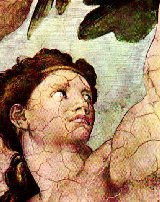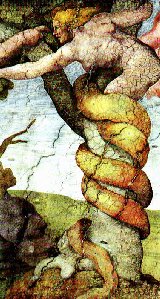| Lilit, Malkah ha-Shadim
By Jeffrey Smith
Of the all the figures in Midrash, it is Lilith who is most clearly Babalon. It might therefore be helpful to investigate her. Lilith, aside from a stray reference comparing her to a "screechowl" (the translation is debatable), does not appear in the Bible itself. It is in Rabbinic midrash (presumably relying on earlier legends) that we find the full delineation of Lilith. The rabbis began with the Biblical reference to man's first creation as a bisexual being--"male and female He [God] created them [the first human]". Some of the rabbis found in this image something similar to what Aristophanes proposed in the Symposium: a dual bodied being later divided into two who must thereafter seek each other out. But others tried to take into account the later creation of Eve detailed further on in the text. If woman was created from Adam, after his initial creation, than what happened to the female created at first? The answer, according to the Midrash, was that she was Lilith; created with Adam, she refused to comply with Adam's demand that she submit herself to him, and in the end fled from him by using the Ineffable Name. Adam then complained to God about his loneliness, and the creation of Eve followed, together with the "Fall" and the Expulsion from Eden. Adam, blaming this on Eve, separated from her, and for a time reunited with Lilith, before finally returning to Eve. (The details of this first soap opera are reported with various embellishments.) Lilith bore Adam a number of children in this interval, who became the demons. After Adam's reconcilation with Eve, Lilith assumed the Queenship of the Demons; in some versions she is the consort of Samael, in others she remains unpartnered. As Queen of the Demons, she kills babies in their cribs (apparently this was the folk explanation of SIDS), but only in the first days of their life. Her greatest opportunity is with infant boys before their circumcision on the eigth day, and in Germanic lands Jews developed the custom of the "Watch-night" to counter her, a semi-magical vigil around the crib on the night preceding the performance of the brit milah. In addition to this, she still produces children, according to a much later Kabbalistic elaboration. These demons are the children of men, as her original offspring were the children of Adam, Lilith being impregnated by the semen produced by masturbation and nocturnal emissions. As may be surmised, the Rabbinic sources do not present Lilith in a favorable light (although Adam does not come off too well either); they were content to see her as filling out the Biblical picture, and as the archetype of the "bad woman". Later, mostly Gentile, writers connected her with the Harlot/Folly figure of Proverbs (most intelligently, Charles Williams's portrait of Lily Sammile in _Descent into Hell_), and leave it at that. Modern feminists, especially Jewish feminists, have tried to show her as une femme ideal, drawing particularly on her spurning of Adam's attempted dominance, and tried to establish her presence among the planets. But Lilith's Babalonic identity goes further than that; and the full legend can profitably comment on Babalon. There are two foci in the legend: Lilith's position as the original mate of Adam, and her later vocation as the destroyer of children. As Adam's "other half" (literally), the whole Adam must include her. The androgynous/hermaphroditic Adam-Lilith in union was the original form of humanity. Thus Lesson 1: Babalon is a vital part of ourselves, and must be integrated into our Selves if we are to be whole. The legend does not say whether this dual human being was joined side by side or back to back. If back to back, then Lilith automatically becomes Adam's Shadow, and just as automatically something which Adam had to deal with, even though he could never actually see her, always there and always out of sight, and always to be cooperated with. (The same is of course true of Adam as viewed from Lilith's perspective.) Side by side, the same applies, although not in such a pictorially dramatic and literal form. Such a conjunction is not conducive to procreation (the unitive emotional side of sex would be rendered in this instance moot), and thus the two halves were divided. Adam could see Lilith not only front to front but also in the round (and she him); but now he must make an effort to unite with him. And here he blundered; instead of accepting her as an equal, he attempted to dominate. (One form of the legend puts this in openly sexual terms: he insisted on utilizing only the classic man-on-top/woman-on-bottom posture. Other forms of the legend depict the error as mutual: she tried to dominate as much as he.) In psychological terms, he identified with his own ego, and not with his full self; confronted with his Shadow/Deeper Self, he rejected it, or at least tried to subject it to the demands of his ego. Lilith's response was to fly away: she literally rose above Adam (now shrunk to the confines of his own ego, not his full, Lilith inclusive self) with the power of the Name. The Ineffable Name is the core of Being, and the generative power of the Cosmos: this indicates how strong the energy must be which allows the liberation of the Deeper Self from the ego, and how potentially catastrophic. (Adam, after all, lost one half of his own self.) Into the picture now comes Eve, the "mother of all living" (Chavvah, derived from Chai, life, is the name in Hebrew; the connection is lost in the Greek-derived version found in English Bibles.) But at first, she is not this; she merely Ishah, Woman, as he was to her Ish, Man. The Biblical text directly speaks of her being an "extension" of man. The verbal usage in Hebrew portrays this almost directly: Ishah is simply extended Ish, Ish with the female ending tacked on, so that we could render it "female man". The English pairing woman/man mirrors this ("woman" derives from "wife-man"). And then, Scripture continues with the image of man cleaving to woman as one flesh: recreating, in other words, the orignal Androgyne. (It may be noted at this point that in some versions of the bisexual creation, Lilith does not appear. In this tradition, Eve is the original female half; the creation from Adam's rib is the separation into two individuals; there is harmony between the sexes, albeit apparently at the cost of the female accepting the dominance of the male.) Ishah is created from Ish's rib, from a part close to the heart (in Biblical terms, the seat of the emotions, will, and soul), and especially personal and intimate; in tactile terms even more intimate than the genitals. (Is not touching somone's else's breast almost always indicative of some emotional bond--the most intimate being the child feeding from his mother). We see here God (reverting to the Midrashic context) giving Adam another Lilith, another half of himself. And, because of the previous history, it must be done on the sly, with Adam in a deep sleep, so he does not conciously realize that Eve is Lilith. Then comes the business of the Tree of Knowledge, in which Adam's first patriarchal effort proves disastrous. (Note the Biblical text: Adam extends the original prohibition, and in doing so leaves Eve believing that the extension is also Divine in origin. The Midrash picks up on this; the snake shows Eve that the extension (not to touch the Tree) can be flouted with impunity, which leaves her to believe that the entire prohibition will not be enforced. And the rest is "history".) For our purposes, it is necessary only to note that Eve, the second Lilith, is the one that leads Adam into attaining the Knowledge of Good and Evil. He is thus made into a spiritually aware human being, because of his Deeper Self--only now, he does not realize that Eve is himself, and the consequences are a cosmic catastrophe, at least on one level. So he goes into a pout, and leaves Eve. But it is at this point that Eve gains her name in the Biblical narrative. The second focus of the Lilith material is the contrast between her offspring and those of Eve. Lilith bears demons; Eve bears humans. Lilith is impregnated by sex that is nominally unfruitful, male autoeroticism, unpartnered. Eve is impregnated by sex that is normal and procreative in the normal, partnered way. And Lilith is tries to destroy the offspring of her rival. Lilith becomes the repository and incubationary of the male sexual drive that can not be satisfied by normal means. It is sex without love, without mutuality, for the sake only of pleasing one's ego: the male complement of the Whore. If we return to our image of Adam as the ego and Lilith as the Deeper Self, then we find that the ego represses and drives into the Deeper Self what it cannot accept, and what it deems as illegitimate. And what is repressed rebounds on the ego in the form of the demonic, destroying what is acceptable and "legitimate" (symbolized by the offspring of Eve). The lesson is, of course, that had the ego not tried to reject its own products, the demonic would not destroy the remaining offspring, and instead been harmonized, the illegitimate with the legitimate. There is a limit to Lilith's power of destruction: when the child under goes the initiation of *brit milah*, circumcision; which symbolizes in two tradtional phrases, being "sealed into the Covenant" and "coming under the wings [protection] of the Shekinah". By the marking of its member, the child becomes a member of the Community of Israel, both in its literal aspect and in its Kabbalastic aspect ("Community of Israel" being one of the terms denoting the Shekinah). This rite is applicable to infants and to adult converts (to whom the phrase "coming under the Shekinah" is often applied), and it is the essential rite of initiation into the Community. (That the brit milah is exclusively performed on males can be ignored in our context, as can be seen by the fact that woman can circumcise: they can initiate, and only someone already initiated can initiate.) The infant/convert is married to the Shekinah. (Cf. Zipporah's circumcision of Gershom in Exodus, and her reference to "Bridegroom of blood".) The Arabs delay this rite to the onset of maturity (we are leaving out the practice of "female circumcision" which is actually contrary to Islamic law and teaching), but Judaism recognizes that children are part of the Community, and can be initiated as well as any adult, even if they have can not take on adult responsiblities. (The ceremonies of bar/bat mitzvah mark this stage, which has legal but no spiritual ramifications, just as the 18th and 21st birthdays have in Western practice.) The circumcised child is literally the Child Crowned and Conquering, even if he and every one else is unaware of it. He has married the Shekinah, and the physical mark upon the sexual organ is one sign of this. And what is the Shekinah? And why does the marriage to the Shekinah put an end to the power of Lilith? Because the Shekinah is Nuit, and the Child has thus attained Nuit, and (on the symbolic level at least) put Babalon/Lilith back into Her proper place, as part of the Child's own Self. For Lilith when recognized/integrated as one's Self loses her destructive power, or rather the power is properly directed and recognized as fruitful. Further cogitations welcome. f901030k@bc.seflin.org
|
   |